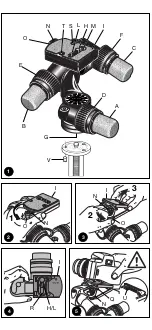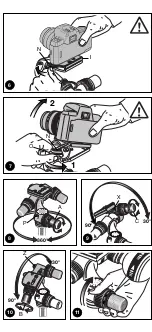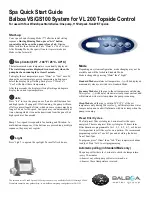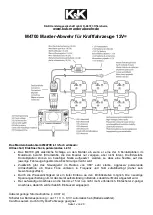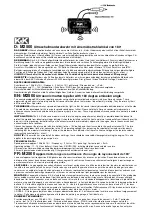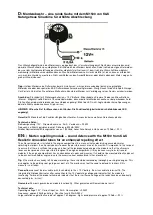
GB
I
E
INTRODUCTION
The head offers precise geared
movement in three directions and is
designed for 35mm SLR, medium and
large format cameras
KEY FEATURES
• Ability to disengage the gear
movement temporarily to rapidly set
the camera in the general position
required and then engage the
geared movements for final
adjustment
• Quick release plate with secondary
security
• 1/4” and 3/8” camera screws
• 3 Spirit levels
SET UP
ASSEMBLING HEAD ON TRIPOD
Assemble the head on the tripod
using 3/8” female thread “G”.
The top plate on Manfrotto tripods
are equipped with three set screws
“V” which clamp against the base
of the head to ensure effective and
secure locking.
REMOVE QUICK RELEASE
PLATE FROM HEAD &
The lever “N” is equipped with a
safety button “O” to prevent the
camera plate “I” from accidentally
being released.
To release the camera plate “I”:
- pull the locking lever “N” in the
direction indicated by the arrow
(fig. 2) until it will go no further
- hold lever “N” in the above position
and at the same time press button
“O” (fig. 3)
- this allows lever “N” to rotate further
thus releasing the camera plate “I”
PLATE CAMERA SCREW
The quick release plate “I” is supplied
with 1/4” “L” and 3/8” “H” camera
screws.
To remove the unused screw:
- remove the rubber cap “M” by
carefully pressing it out with one
finger
- remove the screw “L” or “H”
- replace the rubber cap to prevent
the screw being lost
The head has 1/4” and 3/8” holes for
storing the unused screw.
INTRODUZIONE
Testa a cremagliera progettata per
sostenere fotocamere di medio e
piccolo fomato.
CARATTERISTICHE
• Regolazioni fini e un controllo unico
per ottenere la precisione delle
immagini che desiderate
• Piastra ad intercambio rapido con
dispositivo secondario di sicurezza
• Viti d’attacco per fotocamera da
1/4” e 3/8”
• 3 livelle a bolla d’aria
PREPARAZIONE
MONTAGGIO DELLA
TESTA SUL TREPPIEDE
Montare la testa sul treppiede
utilizzando l’attacco femmina “G” da
3/8” (fig.1).
I treppiedi Manfrotto sono dotati di
tre grani “V” da avvitare contro la
base della testa per un bloccaggio
efficace e sicuro.
SMONTAGGIO DELLA
PIASTRA DALLA TESTA E
La leva “N” (fig. 2) è dotata di
pulsante di sicurezza “O” contro
l’apertura accidentale della piastra
d’attacco “I”.
Per liberare la piastra “I”:
- tirare la leva di bloccaggio “N” nel
senso della freccia (fig. 2) fino al suo
arresto
- tenendo la leva “N” in posizione “1”
premere il pulsante “O” (fig. 3)
- continuare la rotazione della leva
“N” per estrarre la piastra “I”
VITE D’ATTACCO
DELLA PIASTRA
La piastra “I” (fig. 1) è fornita con le
viti da 1/4” “L” e da 3/8” “H” inserite
nella sua feritoia.
Per sostituire la vite non utilizzata:
- togliere, con una leggera pressione
del dito, il tappo in gomma “M”
- togliere la vite “L” o “H”
- reinserire il tappo “M” per evitare la
perdita della vite
La testa è dotata di due fori filettati da
1 /4” e 3/8”, ricavate sotto la sede di
supporto della piastra, per riporre la
vite inutilizzata.
MONTAGGIO DELLA
FOTOCAMERA
SULLA PIASTRA D’ATTACCO
Per fissare la fotocamera alla piastra
“I” (fig. 4) avvitare, SENZA FORZARE,
la vite d’attacco “H” o “L” nel foro
filettato della fotocamera fino a fondo
del filetto. La vite d’attacco “H” o “L”
corre lungo la feritoia “R”.
Prima del bloccaggio definitivo,
allineare l’obiettivo della fotocamera
alla piastra “I” e scegliere la posizione
che consente il miglior bilanciamento
Nota: Le viti d’attacco “H” e “L”
prevedono un intaglio per il fissaggio
mediante l’uso di una moneta.
Nota: La piastra d’attacco “I” (fig. 1) è
inoltre dotata di fori filettati da 1/4”
“S” e da 3/8” “T” supplementari.
MONTAGGIO
DELLA FOTOCAMERA
SULLA TESTA E
Infilare dall’alto la piastra “I” (fig.
5) sulla testa portandola in
appoggio sui due lati inclinati
“U” della sede d’aggancio e
quindi premere la piastra “I”
verso il basso fino allo scatto
della leva di bloccaggio “N”
Assicurarsi che il bloccaggio
della piastra “I” (fig. 6) sia
completo spingendo a fondo la
leva “N” e controllando che la
fotocamera sia saldamente
ancorata alla testa.
SMONTAGGIO
DELLA FOTOCAMERA
Ogni volta che è necessario
togliere la fotocamera dalla
testa tenere saldamente con
una mano la fotocamera e con
l’altra agire sulle leve di
bloccaggio “N” e sicurezza “O”
(fig. 7).
ASSEMBLING
CAMERA ON PLATE
Fix the camera onto the plate "I" by
screwing home the camera screw "H"
or “L” into the Cameras' threaded
hole WITHOUT APPLYING FORCE.
The screw "H" or “L” slides along the
slit "R" allowing you to align the
camera lens with the plate "I" and
there by choose the best balance
position.
Note: The screws “H” and “L” have a
grove in the head to enable them to
be tightened with a coin
Note: The plate "I" (fig. 1) has also
1/4" thread attachment "S" and 3/8"
thread attachment "T"
MOUNTING THE CAMERA
ON THE HEAD &
Insert the camera plate “I” (fig.
5) into the dovetail sides “U” on
top of the head and then press
plate “I” downwards until
locking lever “N” clicks and
closes.
Make sure that plate “I” (fig. 6) is
fully locked by pushing lever “N”
all the way to the left side and
checking that the camera is
fitted securely
REMOVE THE CAMERA
FROM THE HEAD
Whenever the camera needs to
be removed from the head, hold
the camera securely in one hand
while operating locking lever “N”
and safety lever “O” with the
other.
USE
FINE ADJUSTMENT
&
Use the following control knobs (fig. 1)
“A” = Pan
“B” = Tilt
“C” = Levelling
Fine adjustment is made by simply
rotating the control knobs (fig. 8, 9
and 10)
The design of the geared mechanism
enables the camera to be set in
position without the need to lock off
once the required angles are achieved
INTRODUCCION
La rótula proporciona un movimiento
orientable en tres direcciones y ha
sido diseñada para cámaras SLR 35
mm, medio y gran formato.
CARACTERISTICAS PRINCIPALES
• Permite las más finas rectificaciones
con máxima precisión
• Plato rápido con seguridad
adicional
• Doble tonillo de 1/4" y 3/8"
• 3 burbujas de nivel
PREPARACION
ACOPLAMIENTO
DE LA ROTULA AL TRIPODE
Acople la rótula al trípode utilizando
la rosca "G" de 3/8" hembra.
Las plataformas superiores de los
trípodes Manfrotto vienen con tres
tornillos "V" que presionan contra
la base de la rótula para afianzar
un bloqueo seguro.
QUITAR EL PLATO RÁPIDO
DE LA RÓTULA Y
La palanca de bloqueo “N” esta
equipada con un botón de seguro
“O” que impide el que el plato “I” se
suelte sin querer.
Para retirar el plato de la cámara
proceda de la siguiente manera:
- Mueva la palanca de bloqueo “N”
(fig. 2) en sentido de la flecha hasta
tope. Mantenga la palanca en el
punto donde haga tope (pos. 1) y
presione al mismo tiempo el botón
de seguro “O” (fig. 3).
- Ahora podrá mover aún más la
palanca “N” con lo que el plato “I”
quedará suelto.
TORNILLO DEL PLATO
PARA AJUSTAR LA CAMARA
El plato de cambio rápido "I" se
suministra con tornillos de pasos
1/4" "L" y 3/8" "H".
Para cambiar de tornillo:
- Quitar la tapa de goma "M" con
cuidado tirando hacia fuera con un
dedo.
- Quitar el tornillo "L" o "H".
- Volver a poner la tapa de goma
para evitar que se pierda el tornillo.
La rótula tiene agujeros 1/4 y 3/8
para guardar el tornillo que no esta
en uso.
ADAPTAR UNA CAMARA
AL PLATO
Fije la cámara al plato "I" enroscando
el tornillo "H" o “L” en el orificio
roscado de la cámara SIN EMPLEAR
FUERZA.
El tornillo "H" o “L” se desliza a lo
largo de la ranura "R" y le permite
alinear la óptica de la cámara con el
plato "I" escogiendo al mismo tiempo
la mejor posición de equilibrio
Nota: Los tornillos “H” y “L” pueden
apretarse con una moneda.
Nota: El plato "I" (fig. 1) lleva
acoplamiento de rosca 1/4" "S" y de
rosca 3/8" "T".
COLOCANDO LA CÁMARA
EN LA RÓTULA Y
Inserte el plato "I" (fig. 5) en los
lados de cola de milano "U",
arriba en la rótula y luego
presione el plato "I" hacia abajo
hasta que la palanca de
bloqueo "N" encaje y cierre.
Cerciórese que el plato "I" (fig.
6) esté plenamente bloqueado
empujando la palanca "N" todo
lo que dé de si hacia la
izquierda y compruebe que la
cámara esté firmemente cogida
a la rótula.
RETIRAR LA CÁMARA
DE LA RÓTULA
Siempre que la cámara ha de
quitarse de la rótula, coja la
cámara segura con una mano
mientras que maneje la palanca
de bloqueo "N" y la de
seguridad "O" con la otra.
USO Y
La rótula viene equipada con
funciones de ajuste fino y basto que
permiten 3 movimientos diferentes de
la cámara (horizontal, vertical y
picado lateral)
AJUSTE FINO Y
Para realizar movimientos finos de la
cámara puede accionar los siguientes
mandos :
- “A” movimiento horizontal
- “B” movimiento de inclinación
vertical
- “C” movimiento de picado lateral
Pueden deslizarse estos ajustes finos
variando los mandos giratorios
RAPID
ADJUSTMENT &
Use the following control rings (fig. 1)
“D” = Pan
“E” = Tilt
“F” = Levelling
Rapid adjustment can be made by
using a hand to rotate the control
wheel ("D", "E", "F") through 90°
following the arrows (fig. 11). While
holding the control wheel open, the
camera can be rapidly deployed with
the other hand to the desired position.
Release the control ring to lock the
head in position. The head is supplied
with 3 spirit levels: "P" for panning
(fig. 8), "X" for vertical portrait format
(fig. 9) and "Z" for horizontal position
(fig. 10).
USO DELLA TESTA
La testa è dotata di comandi per la
regolazione fine e rapida dei tre
movimenti (pannig - tilting e levelling).
REGOLAZIONE
FINE E
Utilizzare le seguenti manopole (fig. 1):
- “A” (per il panning)
- “B” (per il tilting)
- “C” (per il levelling)
La regolazione fine si ottiene
semplicemente ruotando le manopole
(fig. 1, 8, 9, 10 e 11). Il dispositivo di
regolazione è irreversibile: ciò
permette di posizionare la fotocamera
in modo preciso senza dover agire su
manopole di blocco e sblocco del
movimento.
REGOLAZIONE
RAPIDA E
Utilizzare le seguenti ghiere:
- “D” (per il panning)
- “E” (per il tilting)
- “F” (per il levelling)
La regolazione rapida si ottiene
afferrando con una mano la ghiera per
il movimento rapido e ruotandola di
90° nel senso della freccia (fig. 11);
mantenendo la ghiera in tale
posizione di sblocco della rotazione è
possibile effettuare spostamenti rapidi
sostenendo con l’altra mano la
fotocamera fino al raggiungimento
della posizione voluta. Il rilascio della
ghiera blocca la testa nella posizione
raggiunta.
La testa è dotata di 3 livelle a bolla :
“P” (fig. 8) utile per il livellamento della
panoramica, “X” (fig. 9) per il formato
verticale e “Z” (fig. 10) per la
posizione orizzontale.
simplimente en la dirección
deseada (ver. fig. 8, 9 y 10).
Las variaciones estan autofrenadas.
Por ello no hace falta bloquear
adicionalmente una variación
realizada como ocurre en la
mayoría de las rótulas.
VARIACION
RAPIDA Y
Para realizar variaciones de
posición rápidas puede soltar los
siguientes anillos de bloqueo:
- “D” movimiento horizontal
- “E” movimiento de inclinación
vertical
- “F” movimiento de picado lateral
El ajuste se puede realizar
rápidamente con la mano mediante
rotación de la rueda de control ("D",
"E", "F") en la dirección de las
flecha girando 90º (fig. 11). Mientras
el mando giratorio está abierto, la
cámara puede deslizarse
rápidamente con la otra mano para
conseguir la posición deseada.
Coloque el anillo de control a la
posición de bloqueo de la rótula.
La rótula viene con tres burbujas de
nivel: "P" para la inclinación (fig. 8),
"X" para posiciones verticales y "Z"
para conseguir la posición
horizontal (fig. 10)
LENS
0
330
30
0
270
24
0
21
0
180
15
0
120
90
60
30
Made in Italy
0
330
30
0
270
24
0
21
0
180
15
0
120
90
60
30
Made in Italy
0
330
30
0
270
24
0
21
0
180
15
0
120
90
60
30
Made in Italy
0
330
300
270
240
21
0
180
15
0
120
90
60
30
Made in Italy
N
I
N
O
P
A
Z
B
X
C
2
1
30°
90°
30°
90°
360°
1
1
2
3
4
1
8
9 10
11
1
8
9 10
11
7
5
6
1
1
2
3
4
1
8
9 10
11
1
8
9 10
11
7
5
6
1
1
2
3
4
1
8
9 10
11
1
8
9 10
11
1
8
9
10
7
5
6
6
7
8
10
11
9


